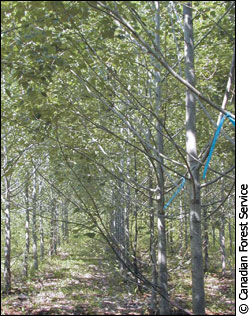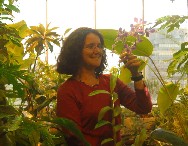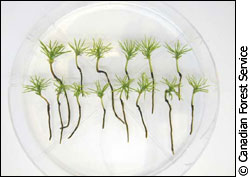| Seeing
the forest for the trees
By Ildiko Kaszas
 |
| Transgenic poplar field. |
OTTAWA —
New controversy erupted in
Argentina last December at the tenth anniversary of
the United Nations conference on climate change. A flood
of activists arrived to protest against genetically
modified organisms. But this time, they'd set their
sights on the world's forests.
Environmentalists denounced the UN's decision
to include genetically modified (GM) trees in its Clean
Development Mechanism. This allows member countries
to use GM technology as a way of reaching carbon emission
targets set out by the Kyoto Protocol.
| 'If these traits
escape into native forests, it will lead to the
destruction and contamination of native forests,
which will worsen global warming' |
During the conference, groups like the
World Rainforest Movement and Friends of the Earth International
released reports on the threats imposed by GM trees.
And Anne Petermann, co-director of the US-based Global
Justice Ecology Project, went so far as to say GM trees
were antithetical to Kyoto.
“If these traits escape into native
forests, which is virtually guaranteed,” said
Petermann in a statement, “it will lead to the
destruction and contamination of native forests, which
will worsen global warming.”
Although Petermann’s claim may seem
a bit far-fetched, fears that GM trees could irreparably
damage the environment are not.
Forest biotechnology is still considered
a relatively new area of research, but fields of transgenic
poplars have already been planted in New Zealand and
China – as well as Sweden and other European countries.
As examples of scientific achievement, these experiments
have attracted their fair share of criticism.
 |
| Dr. Sharon Regan in the
greenhouse. |
In Canada, where GM science proceeds at
a more cautious rate, the story is surprisingly different.
“Those are the exception to the
rule,” says Dr. Sharon Regan, a biology professor
at Queen’s University in Kingston. “You
don’t see plantations of GM trees for commercial
purposes anywhere else but there [New Zealand and China]."
Regan is one of five scientists taking
part in a Genome Canada project on GM poplars. The study
aims to help forestry researchers better understand
the basic biology behind trees.
The study focuses exclusively on that
species, says Regan, because the poplar genome has already
been sequenced. Poplars also adapt well to small spaces
and can be cut back if they grow too tall. But with
a potential sample size of thousands, Reagan’s
greenhouse laboratory is still cramped. The full sample
— between five and seven thousand trees —
will be planted by September 2005.
| 'It’s really
a blind experiment. We really have no idea what
we’re looking for' |
Each tree sample is engineered with some
type of alteration using tissue cultures at the single-cell
stage. Regan uses a section of DNA from a particular
virus to ‘turn on’ genes in each plant.
This DNA strand is inserted into the poplar cells, which
are then left to grow in a greenhouse. 'Activation tagging,'
as it's known, helps scientists track the function of
an individual gene. But they have no way of predicting
where the virus ends up.
 |
| Small transgenic plants. |
“We don’t know where we’re
going to see an effect,” says Regan. “Is
it going to be in the root or the stem or the leaf?
It’s really a blind experiment. We really have
no idea what we’re looking for.”
The entire process, from single cell to
a hand-sized sapling, takes about a year.
Once the poplars have grown enough, researchers
look for any changes that result from the altered gene.
Theoretically, each sample would contain an activated
gene that’s different from the rest, says Regan.
Once scientists have identified an interesting trait,
they can compare the lab's samples to natural populations.
This would help them locate trees with a specific gene
‘turned on’ at a high level. Regan says
those in the forestry industry could eventually come
in and screen these samples for desired traits.
| 'Years
ago people decided we want it whiter, we want it
fleshier, we want it bigger, we want it rounder
and the potato has morphed from the long, thin purple
thing that we used to have several hundred years
ago to the white ones we have now.' |
“We can develop a diagnostic
kit to help find superior trees that are already out
there.”
For Regan, this test would be an
addition to traditional breeding techniques —
not a replacement. As for genetically modifying trees
for commercial purposes, Regan says it won’t be
necessary.
“In agriculture, genetically
modified foods will be necessary because we have lost
a lot of that genetic information over thousands of
years of breeding. In forestry, there’s a huge
diversity already out there.”
She illustrates her point by describing
the common potato:
“Years ago people decided we
want it whiter, we want it fleshier, we want it bigger,
we want it rounder, and the potato has morphed from the
long, thin purple thing that we used to have several hundred
years ago to the white ones we have now.”
In the process, says Regan, the potato
has lost a lot of other genes. After centuries of breeding,
crops have become very susceptible to disease. The difference
in forestry, she says, is that trees have only been
bred for the past 50 years. The potential still exists
that trees can have the same disease-resistant genes
they had 10,000 years ago.
Across the border at Environmental Defense,
Rebecca Goldberg points to other examples of genetic
modification gone wrong. Goldberg says that because
most crops harvested today originated from abroad, they
don’t have natural variants to interbreed with.
Trees that are cultivated for pulp and paper, on the
other hand, have wild relatives that promote genetic
diversity. And unlike crops, trees take a much longer
time to reach maturity.
| 'The notion
that one could engineer trees to be sterile over
thousands and millions of acres over a lifespan
of trees and have them all stay sterile just doesn’t
seem very realistic.' |
“With croplands, they’re typically
just grown for one year and removed, and so if there’s
evidence of a problem, at least the crops aren’t
grown all the time. With trees, you plant them, they
stay in the ground for decades, they may flower numerous
times, so there’s more opportunity for gene flow
to wild relatives.”
Goldberg says the potential to engineer
sterility does exist, but natural selection favours
the restoration of fertile traits.
“If you know anything about evolution,
that makes sense,” says Goldberg. “Sterility
might work on a short timescale to enable an experiment,
but the notion that one could engineer trees to be sterile
over thousands and millions of acres over a lifespan
of trees and have them all stay sterile just doesn’t
seem very realistic.”
Even if trees are engineered fairly quickly,
she says, it takes a while to see what the effects are.
“Once you put in genetically engineered
trees on a large scale, if something goes wrong, the
economic cost of ripping them out is enormous,”
says Goldberg. “It may be hard, politically, to
reverse even an acknowledged mistake.”
Dr. Armand Séguin and his team
at the Laurentian Forestry Service are dealing with
these issues first-hand. On a plantation in Northern
Québec, Séguin is conducting the first
ever field trial of transgenic poplars in Canada.
The study is being closely monitored by
the Canadian Food Inspection Agency, the regulatory
body responsible for all GM testing. Although the poplars
being used in the trial are sterile, they are still
monitored for signs of flowering and pollination on
a regular basis. Because pollen can travel over great
distances, the prospect of contaminating native forests
is a particularly worrisome threat.
“We have to climb on ladders and
look through binoculars to see their tops and check
for flowering because the poplars grow so fast,”
says Séguin.
| 'When you
eat beef, you eat beef DNA. When you eat salad,
you eat salad DNA. It doesn’t mean you take
on those traits.' |
And even after the trees are cut down,
the CFIA insists that the stumps are completely uprooted
and destroyed. Séguin calls this process ‘restrictive.’
But like Regan, Séguin says his main goal is
simply to better understand trees.
The poplars used in Séguin’s
field trial each contain two marker genes . These markers
check to see whether genetic transformation has taken
place. They also monitor for genes that may end up in
the soil through leaf and branch decomposition. Séguin
says the persistence of genetic information should not
be a concern.
“When you eat beef, you eat beef
DNA. When you eat salad, you eat salad DNA. It doesn’t
mean you take on those traits.”
Séguin says there’s no way
to guarantee that genes from GM trees will not be transferred
into native forests. But he says that cross breeding
and genetic modification happens all the time in nature..
“If a gene doesn’t have a
specific advantage, then it’s diluted in the environment,”
says Séguin. “There’s no current
research to suggest that GM trees are any more harmful
than regular trees to humans or the environment.”
For Séguin, it boils down to a
fear of the unknown. He says field trials of GM trees
are necessary because “we’re already in
the red.” New pests are always one step ahead
of modern technology and destroying our forests. If
we didn’t have a problem, says Séguin,
then there would be no need for genetic modification.
When it comes to pest management, Regan
agrees.
“We have two choices,” she
says. “Either lose the tree completely and just
never grow it again, or introduce a tree — the
same kind that has a genetic modification that gives
it resistance to that bug.”
But for Goldberg, the answer is not so
straightforward. GM trees aren’t necessarily the
answer to the demands put on natural forests. If scientists
engineer trees to be resistant to certain pests, she
says, they may be also depriving other species of food.
The potential effects need to be viewed both up and
down the food chain.
As for commercial tree plantations —
like those currently found in New Zealand and China
— the reviews are mixed.
| 'It’s
one thing for some tree plantation to put in a more
domesticated, genetically engineered tree that’s
safe. It’s another if the forest service starts
planting them.' |
“Producing more wood on tree farms
isn’t necessarily a bad thing, if you can make
the tree farms more productive,” says Goldberg.
“But there also are questions about doing the
farming in a way that’s ecologically sound. One
has to consider all the tradeoffs. It’s one thing
for some tree plantation to put in a more domesticated,
genetically engineered tree that’s safe. It’s
another if the forest service starts planting them on
land that’s used for conservation purposes.”
Regan says it’s likely trees will
be genetically engineered with very special chemical
properties so their wood can be used by different industrial
sectors.
“Really, the sky’s the limit
on what kind of changes could be put onto those [trees]
that could meet so many demands in other areas,”
says Regan. This could include better thread for surgery,
parts for electronics and improved wood materials, like
rayon. “It’s kind of like designer wood,”
she says.
In Regan’s greenhouse, the poplars
are already showing radical differences in appearance
— some plants developed leaves with jagged edges,
while others maintained the smooth, flat leaves common
in poplars. Regan says she’s spotted at least
10 unusual plants, but expects that number to increase
when screening begins.
“It’s exciting, it means the
whole technology is working,” she says. “The
strategy works.”
The potential benefits of GM research
are enormous: better wood for the pulp and paper industry,
and resistance to alien pests and bioremediation --removing
metals from infertile soil. And Canada is one of the
few countries left in the world with its natural forests
still intact.
“We’re in a relatively unique
opportunity to preserve those [natural forests], and
so a lot of the push — both from scientists and
the industry — is to change our forestry practice,
move it away from taking trees from natural forests
and instead move to plantation forestry,” says
Regan. But these plantations would still consist of
natural trees and not ones that are genetically modified.
Regan’s team plans to monitor the
poplars for the next 10-15 years. The trees will have
to be followed over the long term, she says, because
certain traits may not show up for several years. Regan
says she expects to get the most out of her study by
analyzing the poplars repeatedly over the next two decades.
| 'Reforestation
with GM trees is like money you gain and then lose,
not like money that’s already been stolen.' |
And that’s about how long it would
take before GM trees would be seen on the open market.
According to Séguin, they won’t become
commercially viable for at least another 10 or 15 years.
Until then, both scientists and policy makers will have
to take the process one step at a time. Séguin
says the trick is to find a balance between the unknown
risks of genetic modification, and the more obvious
risk of doing nothing.
“Reforestation with GM trees is
like money you gain and then lose, not like money that’s
already been stolen.”
|